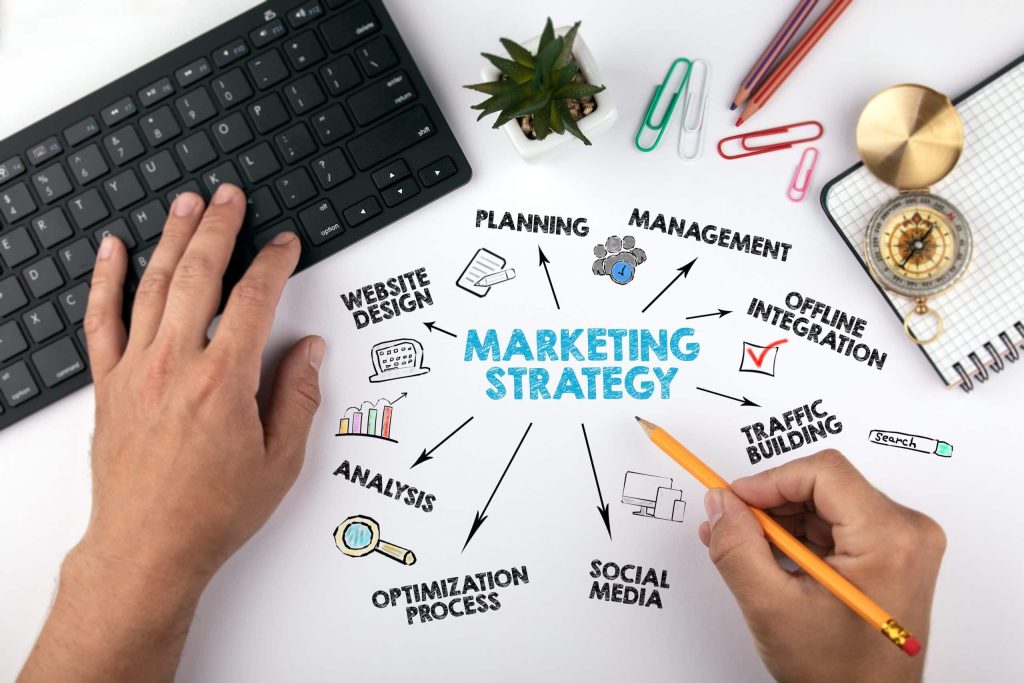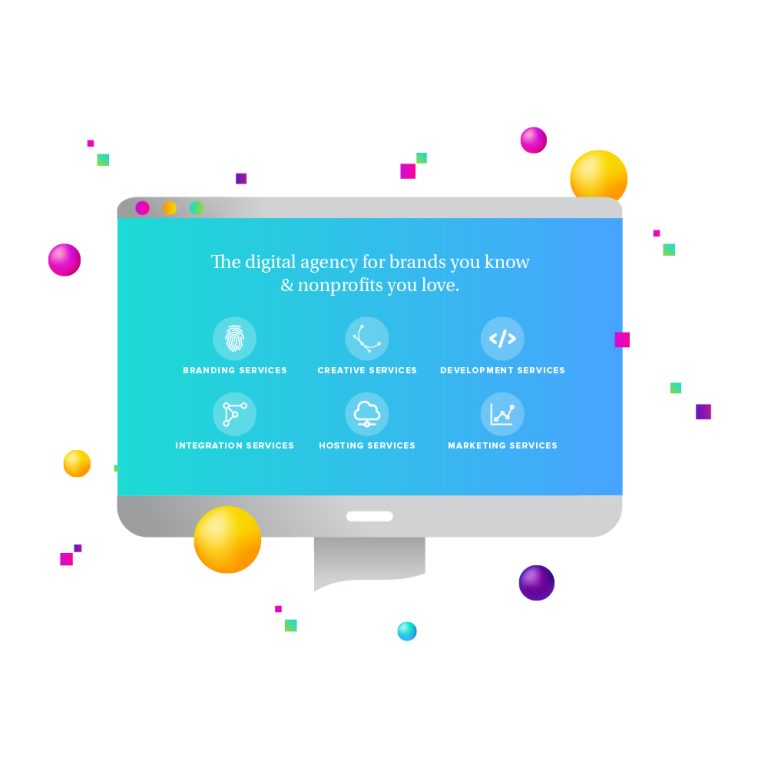
The role of a well-crafted nonprofit digital strategy has never been more vital. Nonprofits, driven by their missions to create positive change and serve their communities, must harness the power of digital tools and channels to maximize their reach, engagement, and impact. A comprehensive nonprofit digital strategy serves as a roadmap, guiding nonprofits to effectively communicate their purpose, build lasting relationships with supporters, raise essential funds, and advocate for change.
Nonprofit Digital Strategy Step 1: Determine Who You Are
Engaging in a comprehensive discovery process with staff, management, and stakeholders is an indispensable step for a nonprofit organization. It serves as a critical compass for navigating the nonprofit marketplace. By collectively delving into questions about identity, differentiation, and competition, a nonprofit can uncover its unique strengths and understand its place in the broader ecosystem.
This shared exploration not only fosters a deep sense of purpose and alignment within the organization but also sharpens the ability to communicate its value proposition. In doing so, it empowers the nonprofit to stand out in a crowded landscape, showcase its distinctive qualities, and strategically position itself against competitors. This introspective journey is the foundation upon which effective strategies and impactful missions are built, enabling nonprofits to better serve their communities and drive positive change.
Nonprofit Digital Strategy Step 2: Determine Who Your Audience Is
Before embarking on an extensive and resource-intensive digital marketing campaign, it is paramount for a nonprofit to precisely define and understand its target audience. This step serves as the linchpin of any successful strategy. By identifying the characteristics, needs, and preferences of their audience, nonprofits can tailor their digital efforts to resonate with the right people and maximize impact.
It is also critical to determine where in the digital landscape they “live.” Engaging in a TikTok campaign when all of your key supporters are over 65 is not a sound strategy, but perhaps Facebook is a better platform. This not only ensures that resources are invested wisely but also fosters a deeper connection with supporters, leading to higher engagement and more effective outcomes.
Nonprofit Digital Strategy Step 3: Define Your Goals
Defining goals for your nonprofit’s digital strategy is a fundamental step that should precede any efforts in this domain. These goals serve as the compass guiding your organization’s digital initiatives. These objectives need to be clear, attainable, and aligned with your organization’s mission.
Prioritization is crucial. Identify which goals will have the most significant impact in the short and long term. Consider metrics and key performance indicators (KPIs) to gauge your progress. These might include website traffic, conversion rates, social media engagement, or fundraising targets.
Assess your available resources, such as budget, staff, and technology. Ensure that your goals are feasible given your available resources.
Take both short-term and long-term goals into account. Short-term goals might address immediate needs, while long-term objectives could focus on sustainability and growth.
Be open to adapting your goals as your digital marketing strategy unfolds. The digital landscape is ever-changing, and flexibility is key. What will always be necessary is improving nonprofit SEO.
Integrate your digital marketing goals with your overarching organizational strategy. They should complement and support other activities and initiatives.
Effectively communicate your goals with your team and stakeholders. Ensure that everyone is on the same page and committed to working toward these objectives.
Schedule regular reviews to track progress, identify areas for improvement, and celebrate your achievements.
Defining clear and realistic goals for your nonprofit’s digital marketing strategy is pivotal to channel your efforts effectively, maximize your impact, and demonstrate success in alignment with your mission. These goals provide a roadmap for your organization to engage with your audience, extend your reach, and drive positive outcomes.
Nonprofit Digital Strategy Step 4: Choose Your Platform and Tools
A nonprofit’s choice of digital marketing platforms and tools should align with its specific goals, target audience, and available resources. Here are some essential platforms and tools commonly used in nonprofit digital marketing campaigns:
Website: A well-designed and user-friendly website is the central hub for your digital presence. It should provide information about your mission, programs, and ways to get involved.
Content Management System: Tools like WordPress and Drupal help manage and update website content easily.
Social Media: Leverage popular social platforms such as Facebook, Twitter, Instagram, and LinkedIn to connect with supporters, share stories, and promote campaigns.
Email Marketing Software: Platforms like Mailchimp, Constant Contact, and HubSpot facilitate email campaigns, newsletters, and automated communication with supporters.
SEO Tools: Use tools like Google Analytics, Moz, and Semrush to optimize your website for search engines and track organic traffic.
Pay-Per-Click Advertising: Google Ad Grants can provide nonprofits with free advertising credits, allowing you to run Google Ads campaigns.
Social Media Advertising: Platforms like Facebook Ads, Twitter Ads, and LinkedIn Ads enable targeted advertising to reach specific demographics.
Content Creation Tools: Tools like Canva and Adobe Creative Cloud can help create eye-catching graphics and visuals.
Video Platforms: Platforms like YouTube and Vimeo allow for video content sharing, which can be particularly impactful in conveying your mission.
Email Fundraising Platforms: Tools like Classy, Donorbox, and GiveWP enable nonprofits to collect online donations through email campaigns.
CRM (Customer Relationship Management): CRM systems like Salesforce, HubSpot, and Zoho CRM help manage donor and supporter relationships.
Marketing Automation Tools: Tools like Marketo, Mailchimp, and HubSpot provide automated workflows for email marketing and engagement.
Peer-to-Peer Fundraising Platforms: GoFundMe, Crowdfundr, and peer-to-peer fundraising software like Classy can help supporters raise funds on your behalf.
Online Event Platforms: Tools like Eventbrite and Zoom can assist in organizing and promoting virtual events and webinars.
Advocacy and Mobilization Tools: Platforms like Phone2Action or Change.org help engage supporters in advocacy campaigns and petitions.
Analytics and Reporting: Google Analytics, social media insights, and email marketing analytics provide data for measuring campaign success and making data-driven decisions.
A/B Testing Tools: Optimizely and Google Optimize help optimize website content and improve conversion rates.
Social Media Management Tools: Platforms like Hootsuite, Buffer, and Sprout Social allow for scheduling, monitoring, and analyzing social media activity.
Online Survey Tools: Platforms like SurveyMonkey and Typeform can be used to gather feedback and insights from supporters.
Podcasting Tools: For nonprofits exploring podcasts, tools like Anchor or Libsyn help with recording and publishing content.
The selection of platforms and tools should be guided by your nonprofit’s unique needs and budget. It’s important to continuously assess the effectiveness of these tools and make adjustments as needed to optimize your digital marketing efforts.
Nonprofit Digital Strategy Step 5: Develop Your Content
Determining what content to produce as part of a nonprofit digital strategy is a crucial decision that should be based on the organization’s goals, target audience, and available resources.
Define Clear Objectives
Start by setting specific, measurable, and achievable goals for your digital marketing campaign. Whether it’s raising awareness, increasing donations, or engaging volunteers, knowing your objectives will inform your content choices.
Audience Research
Understand your target audience’s preferences, needs, and pain points. Create detailed audience personas to guide content creation. What questions are they asking? What challenges are they facing?
Content Mapping
Create a content map that outlines the various stages of your audience’s journey, from awareness to engagement and conversion. Develop content that aligns with each stage, addressing their specific needs and concerns.
Leverage Your Mission and Stories
Your nonprofit’s mission is at the heart of your content. Share stories, impact stories, and case studies that showcase the real-world difference you make. Emotional and relatable stories resonate with audiences.
Content Types
Consider a mix of content types, including blog posts, videos, infographics, podcasts, webinars, case studies, and whitepapers. Diversifying content keeps your strategy fresh and engaging.
Educational Content
Provide educational content that informs your audience about your cause and its importance. Explainers, how-to guides, and fact sheets can be valuable resources.
Visual and Interactive Content
Visual content, such as images, videos, and infographics, is often more shareable and memorable. Interactive content, like quizzes and surveys, can boost engagement.
Timely and Trend-Relevant Content
Stay up to date with relevant news and trends in your sector. Create content that connects your mission to current events, sparking discussions and engagement.
Calls to Action
Every piece of content should include a clear call to action that guides the audience towards the next step, whether it’s donating, signing a petition, or sharing the content.
Content Calendar
Develop a content calendar that outlines the topics, formats, and publication dates for your content. Consistency in publishing is key to maintaining audience engagement.
User-Generated Content
Encourage supporters and beneficiaries to share their own stories, photos, and experiences related to your nonprofit. User-generated content can be highly authentic and compelling.
SEO and Keyword Research
Use keyword research to identify relevant search terms and phrases. Optimize your content for search engines to improve discoverability.
Feedback and Analytics
Continuously analyze the performance of your content using tools like Google Analytics and social media insights. Pay attention to which content types and topics are resonating most with your audience and adjust your strategy accordingly.
Adaptability
Be ready to adapt your content strategy based on what you learn from your analytics and audience feedback. Experiment with different content approaches to find what works best for your nonprofit.
Incorporating these steps into your content planning process ensures that your nonprofit’s digital marketing campaign aligns with its mission, effectively reaches its target audience, and supports the achievement of its goals.
Nonprofit Digital Strategy Step 6: Execute and Adjust
Effective execution, analysis, and continuous adjustment based on data are essential for success. Here are the steps to take in each phase of your nonprofit digital marketing campaign:
The Execution Phase
Campaign Launch: Begin by launching the digital marketing campaign on the selected platforms and channels, ensuring all content and assets are live and accessible to the target audience.
Monitoring and Tracking: Implement tracking tools such as Google Analytics, social media analytics, and email campaign tracking to monitor the performance of your campaign from the outset.
Engagement and Response: Actively engage with your audience by responding to comments, messages, and inquiries promptly. Foster a sense of community and interaction around your campaign.
Content Scheduling: Stick to your content calendar, regularly publishing content across various channels and maintaining consistency in your messaging.
Ad Management: If running paid advertising, closely monitor ad performance and adjust budgets, targeting parameters, and ad creatives as needed to optimize results.
The Analysis and Reporting Phase
Data Collection: Gather data on key performance indicators such as website traffic, conversion rates, social media engagement, email opens and click-through rates, and more.
Benchmarking: Compare the collected data to your predefined campaign objectives and benchmarks to assess performance.
Analytics Review: Analyze the data to identify trends, patterns, and areas where the campaign is succeeding or falling short of its goals.
A/B Testing: If applicable, review results of A/B tests and experiments to determine which content or approach is more effective.
Audience Insights: Use data to gain insights into your audience’s behavior, preferences, and any changes in their interests.
Competitor Analysis: Assess your competitors’ digital marketing efforts and adjust your strategy based on what is working for them.
The Adjustment Phase
Strategic Tweaks: Based on your analysis, make strategic adjustments to your campaign. This may include revising content, shifting advertising budgets, or refocusing on specific platforms.
Content Optimization: If certain types of content or messaging are particularly successful, replicate and build upon them. Conversely, discontinue or adjust content that underperforms.
Conversion Rate Optimization: Optimize your website and landing pages to improve conversion rates. Make it as easy as possible for users to take the desired action.
Resource Allocation: Shift resources to where they are most effective. If a particular channel is delivering superior results, allocate more resources there.
Feedback Integration: Act on feedback from your audience and volunteers, incorporating their insights into the campaign.
Regular Reporting: Continue to generate regular reports to keep stakeholders informed of campaign progress and any adjustments made.
Iterative Approach: Understand that digital marketing is an iterative process. Be open to continuous adjustments and improvements based on new data and insights.
Throughout this process, communication and collaboration within your team are vital. Regularly discuss your findings, insights, and the adjustments you plan to make. Adapting to the data and audience feedback allows your nonprofit to continually optimize its digital marketing efforts for maximum impact.
Challenges for Nonprofits in Washington D.C.
Standing out among the fierce competition of the 50,000 other nonprofits in Washington, D.C. requires a combination of strategic actions and a unique approach. Here are some tangible steps a nonprofit can take to set itself apart:
- Craft a powerful and emotionally resonant narrative that communicates the significance of your mission. Share stories that showcase the real-life impact of your work.
- Mobilize your supporters to become vocal advocates for your cause. Engage them in grassroots campaigns that demonstrate your commitment and passion for the issues you address.
- Embrace innovative communication channels, such as podcasting, virtual reality experiences, or interactive online platforms, to engage your audience in new and exciting ways.
- Seek out partnerships with other nonprofits, businesses, government agencies, and academic institutions. Collaborative efforts can amplify your impact and reach new audiences.
- Explore opportunities for public-private partnerships to leverage government resources, corporate support, and nonprofit expertise to drive systemic change.
- Stakeholder Engagement: Actively involve your stakeholders, including donors, volunteers, and beneficiaries, in the decision-making process. Show that you value their input and are accountable to them.
By implementing these strategies, a nonprofit in Washington, D.C. can not only distinguish itself in a crowded landscape but also build trust, foster relationships, and create a lasting impact that resonates with the community and supporters.
New Target has emerged as a steadfast ally for nonprofits seeking to harness the full potential of the digital realm. With a rich history of supporting these organizations in their digital strategies, including content marketing for nonprofits and website design for nonprofits, New Target has consistently demonstrated a commitment to empowering nonprofits to succeed in the dynamic and competitive online landscape. By providing cutting-edge expertise, tailored solutions, and a deep understanding of the unique needs of the nonprofit sector, New Target has fostered lasting partnerships that drive social impact. As we move forward into an increasingly digital future, the expertise and support offered by New Target remain invaluable assets for nonprofits striving to make a meaningful difference in our ever-connected world.



